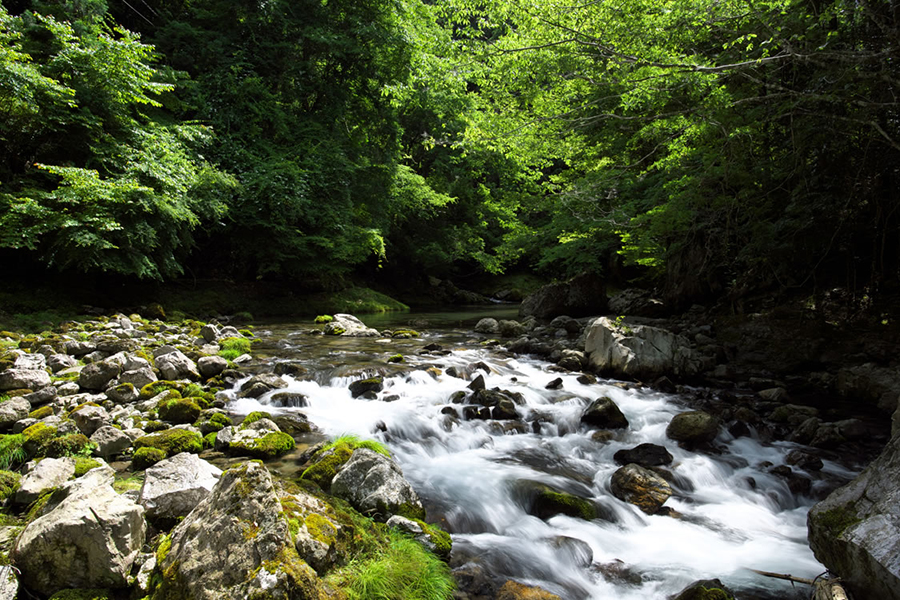The Forest at the River’s Source

For more than 500 years, a forest has stood untouched at the headwaters of the Yoshino River, where the river’s flow is little more than a web of brooks and streams. There, rain and snowmelt from the mountains run down between great, mossy boulders, forming ever-larger cascades of pure mountain water that are crucial to the entire river ecosystem. Between 1999 and 2002, the town of Kawakami purchased 740 hectares of this vital forest to safeguard it from human intrusion.
Spanning elevations from 470 to 1,099 meters, the forest is a mix of Japanese beech, horse chestnut, himeshara (Stewartia monadelpha), and over 390 other species of trees and shrubs. Animals including the Japanese serow, Odaigahara salamander, and Japanese stream toad inhabit the wood, together with the tiny gossamer-winged butterfly Celastrina sugitanii, whose habitat is rapidly disappearing elsewhere.
In addition to nurturing plant and animal life, the forest is essential to regulating the Yoshino River’s water level. In times of excessive rain, the trees and soil absorb water, preventing flooding downhill. In times of drought, the trees retain enough moisture in the soil to keep the river flowing and to sustain the surrounding plants and animals.
To protect the vital forest, entry is limited to guided tours. To participate, those interested can contact the Forest and Riverhead Museum Genryūkan.
Kawakami’s Pledge

The town of Kawakami sits at the headwaters of the Yoshino River (known also as the Kinokawa River), and its residents take their role as guardians of the watershed seriously. In 1996, the town formally pledged to protect the river’s headwaters and the virgin forest that surrounds it. Their five-part pledge includes the hope that future inhabitants and visitors alike will pursue a more respectful and sustainable relationship with nature.
The pledge reads:
As residents of Kawakami, we…
…recognize that we inhabit the origin of an irreplaceable water source and pledge to keep the water clean for everyone and everything downstream.
Between 1999 and 2002, the town purchased 740 hectares of pristine forest at the river’s source and made it a protected area, limiting human access.
…will protect the mountains and water by developing local industry in harmony with nature, creating a fulfilling way of life not found in the city.
Shimotako Planted Forest, located in central Kawakami, is one of the nation’s oldest planted forests, and sustainability is central to its management. The centuries-old cedars and hinoki cypresses that grow there are of such size and quality that they have been designated for use in future repairs to shrines, temples, and other cultural heritage sites by the Agency for Cultural Affairs. It is one of only 80 forests nationwide that have received that designation.
…will strive to give those outside Kawakami opportunities to experience the precious natural world found here.
Each year, new trees are planted in Kyū-Shiraya and other areas. Town associations partner with businesses across the country to plant saplings, adding to the area’s future beauty while forging connections between Kawakami and the wider world.
…will create a place where children are moved by the fundamental essence of life itself.
Children in the town study the local river basin and how it has shaped the area’s history and ecology. They also learn the importance of water in agriculture by planting, growing, and harvesting rice.
…will seek to form a relationship with nature that serves as an outstanding example of human interaction with the global environment.
The village’s initiatives have garnered nationwide attention. In 2014, Emperor Akihito (r. 1989–2019) and Empress Michiko visited Kawakami for a national summit focused on the link between forests and healthy water sources. Kawakami was chosen to host the summit in recognition of the village’s efforts to protect the Yoshino River’s headwaters.
These are just some of the steps that the Kawakami community has taken to honor its 1996 pledge. Today, the town is actively pursuing more than a dozen initiatives that combine community-building with respectful stewardship of the surrounding environment.
